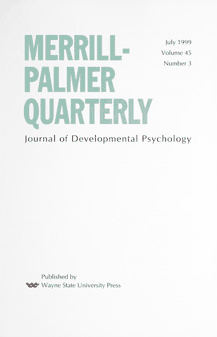Volume 45, Issue 3 (1999)
Articles
Strategies of Play and Winning the Game:
A Reply to Brian Vaughn
Patricia H. Hawley
Prediction of Early Childhood Negative Emotionality
and Inhibition From Maternal Distress During Pregnancy
Roy P. Martin, Jennifer Noyes, Joseph Wisenbaker, and Matti O. Huttunen
Mothers' and Infants' Spontaneous Vocal, Verbal,
and Action Imitation During the Second Year
Elise Frank Masur and Jennifer E. Rodemaker
Consistency and Change in Children's Emotionality
and Regulation: A Longitudinal Study
Bridget C. Murphy, Nancy Eisenberg, Richard A. Fabes, Stephanie Shepard, and Ivanna K. Guthrie
Relations of Children's Social Status
to Their Emotionality and Regulation:
A Short-Term Longitudinal Study
Patricia Maszk, Nancy Eisenberg, and Ivanna K. Guthrie
Parent and Adolescent Temperaments
and the Quality of Parent-Adolescent Relations
Nancy L. Galambos and Pamela K. Turner
Postpartum Transitions in Adolescent Mothers'
Romantic and Maternal Relationships
Christina B. Gee and Jean E. Rhodes
Open Access Article
Consulting Editors
Merrill-Palmer Quarterly Editors

